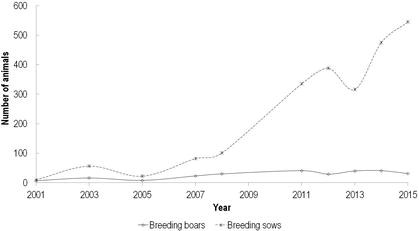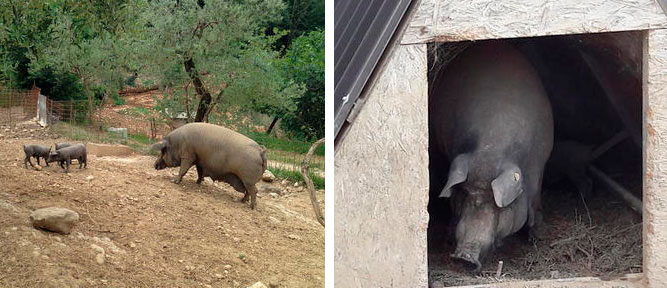History and current status of the breed
The census of Casertana pig breed is presented in Figure 1. Presently there are 20 registered farms of Casertana pigs with about 545 breeding sows and 20 boars in the latest available status (August 2015). The presence of hairless pigs in Campania with a short and broad head, resembling the Asian pigs, is already documented in Roman times. Casertana breed originated from the repeated crossing of these pigs with those of Central European origin. Already at the end of the eighteenth century, the Casertana pig was raised in one of the most populated areas of the Bourbon Kingdom, where it was appreciated for its great ability to produce fat. In the nineteenth century, the Casertana pig was present in the province of Caserta, its area of origin. Starting from its area of origin, the breed spreads in the provinces of Naples, Benevento, Avellino, Salerno and Potenza, and during the early decade of the twentieth century was one of the largest populations of the country. After World War II, the consistency contracted drastically, and only the start of the conservation programme in 2001 facilitated the opening and development of numerous small breeding nuclei.


Exterior phenotypic characteristics
The Casertana pig is a medium-sized breed with two unusual physical traits: it is virtually hairless, which gives rise to its alternative name Pelatella, ‘hairless one’, and it has two wattles or cylindrical appendages hanging from the lower part of the throat. Animals present light but solid skeleton with pigmented skin (black or slate grey) and sparse and thin bristles, sometimes grouped especially on the neck, on the head and at the end of the tail. The head is of medium development and truncated conical shape, with a rectilinear or slightly concave profile and long and thin snout. Ears are of medium-sized close together and bending forward (Figure 2). The Casertana pig breed morphology information is summarised in Table 1.

Table 1. Summary of morphology information on Casertana pig breed.
| Measurement (average) | Adult male | Adult female |
|---|---|---|
| Body weight (kg) | 140–260 | 140–260 |
| Body length1(cm) | 116 | 112 |
| Height at withers (cm) | 90–94 | 82–88 |
| Number of teats (average) | 12 | 12 |
1Measured from the tip of the nose to the starting point of the tail.
Geographical location and production system
Casertana breed is raised in different Italian regions: Campania, Molise, Lazio and Umbria. The traditional breeding technique foresees a wide use of grazing in beech, chestnut or oak woods, with poor feed integration and with large spaces where the Casertana pig can freely graze. Currently, most of the animals are fattened according to modern breeding techniques, with the use of protein nuclei and integrated feed even if breeding with extensive and semi-extensive management is still present, usually in the oaks. When animals are intensively raised, they are kept continuously confined with basic heat protections available even if the environment is not completely climate controlled.
Productive performance
Reproductive traits
According to the herdbook data, the age of sows at the first parturition is 24.5 months, whereas the age at culling is 46.7 months. Sows of Casertana pig breed have 1.1–1.3 litters per year with 6.0–9.2 piglets of approximately 1.0 kg live body weight and 4.2 kg weaning weight. Stillborn percentage of piglets is low (around 2.7%), whereas piglet mortality rate until weaning is considerably higher (around 20.4%). The duration of the farrowing interval (approximately 305 days) is prolonged compared to modern pig breeds.
Growth performance
Due to big differences between studies with regard to the live weight range covered, we defined the stages for early, middle and late fattening stages estimated between approximately 30 and 60 kg, 60 and 100 kg and above 100 kg live body weight, respectively. Sometimes the source provided only the overall growth rate for the whole fattening stage (defined as overall) or even from birth to slaughter (defined as birth to slaughter, which is often calculated from the data given on live weight and age of pigs). It should also be noted that a big part of the collected studies simulated practical conditions of the production systems used and that only a smaller part of the studies aimed at evaluating the breed potential for growth. In the considered studies, the early, middle, late and overall fattening stage is generally characterised by slower growth (477, 464, 446 and 453 g/day, respectively), whereas no data were available for growth performance in lactation and growing period.

In the considered studies, the information on feed intake and feed nutritional value were scarce, which limits the evaluation of growth potential. In the only available study by Fortina et al. [15], the average daily feed intake reported for the overall fattening period (body weight from 33 to 200 kg) was 2.1 kg/day (declared as semi ad libitum feeding with complete feed mixture containing 13.8 MJ/metabolisable energy and 17% crude protein).
Body composition and carcass traits
The basic data obtained in this review with some of the most commonly encountered carcass traits that could be compared are presented in Table 5. In the considered studies, pigs of Casertana breed were slaughtered at approximately 375 days of age and between 120 and 200 kg live weight (154 kg in average). Dressing yield was around 81%. The average backfat thickness values measured at withers were 73 mm, at the level of the last rib 46 mm and above the gluteus medius muscle 60 mm. Muscularity measured as lean meat content was 42.1% (SEUROP classification), whereas data providing other measurements of muscularity (i.e. loin eye area or muscle thickness measured at the cranial edge of gluteus medius muscle) were not available in the considered studies.
Meat and fat quality
The basic data obtained in this review with some of the most commonly encountered meat and fat quality traits measured in longissimus muscle that could be found are presented in Table 6. In the studies reporting meat quality of Casertana pigs, pH measured in longissimus muscle at 45 min and 24 h post-mortem was around 6.23 and 5.7, respectively. The intramuscular fat content was 2.0 and 4.7% and colour measured in CIE L, a, and b colour space was 42, 9.1 and 4.3 for L*, a* and b*, respectively. In the considered studies, SFA, MUFA and PUFA content of intramuscular fat in longissimus muscle was around 43, 45 and 13%, respectively. Due to big differences between studies about the feeding regime, feed composition, final body weight/age and fatness, which are all important factors influencing the fatty acid composition of meat, the results of the fatty acid composition should be interpreted with caution.
Use of breed and main products
Casertana breed has a good fattening attitude, and the fat tends to spread widely throughout the meat making it soft and tasty. Traditionally raised with the semi-extensive system, mainly fed with acorns, chestnuts, walnuts and wild fruits, it is slaughtered between 16 and 24 months, obtaining meat of good quality with tenderness as a special attribute. The most prized characteristic of the Casertana pig is the ‘marbling’ of the meat, i.e. the presence of abundant intramuscular connective tissue (noble fat), which gives flavour and softness to the meat. Meat is used both for cured products and fresh consumption. The main typical products are hams, ribs and above all different types of salami (capocollo, pancetta, and soppressata).
Full text and references are available here: Nero Casertano Pig
Riccardo Bozzi, Maurizio Gallo, Claudia Geraci, Luca Fontanesi and Nina Batorek-Lukač (February 6th 2019). Nero Casertano Pig, European Local Pig Breeds - Diversity and Performance. A study of project TREASURE, Marjeta Candek-Potokar and Rosa M. Nieto Linan, IntechOpen, DOI: 10.5772/intechopen.83778. Available from: https://www.intechopen.com/books/european-local-pig-breeds-diversity-and-performance-a-study-of-project-treasure/nero-casertano-pig



